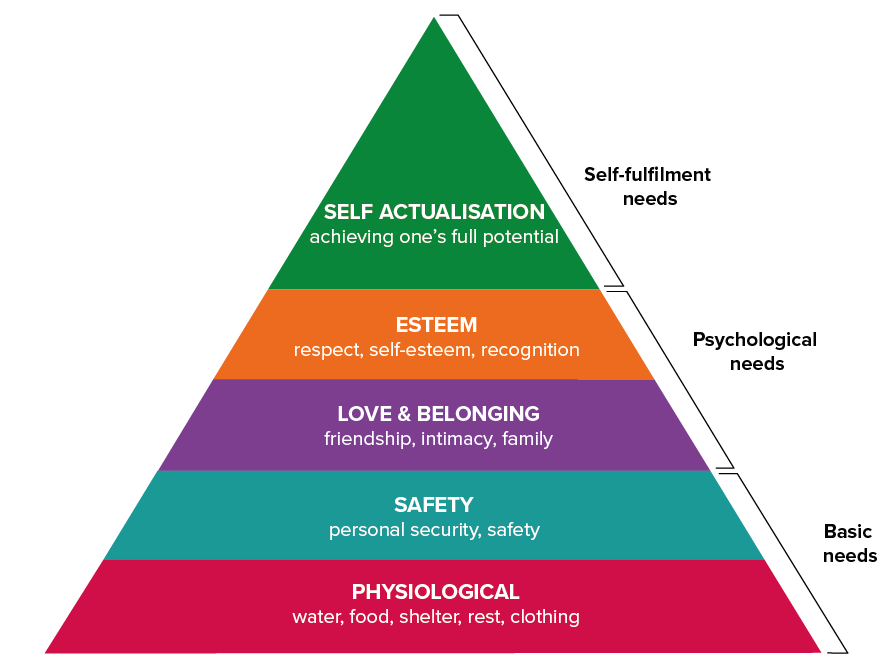Drop off your CV
We'd love to hear from you. Send us your CV and one of our specialist consultants will be in touch.

Whilst the saying ‘the grass isn’t always greener’ can be true, there is always a possibility that it might be, especially when it comes to your job and fulfilling your career goals.
It may be that you feel content in your current role, however, there could be a role or opportunity that offers you more success and satisfaction. Looking at your current role, if we were to apply Maslow’s Hierarchy of Needs to your career, where would you sit? For those not familiar with this theory, it is, in essence, a pyramid of human needs with each level needing to be fulfilled before you move on to the next tier. The top tier is ‘self-actualisation’, where an individual is said to be able to achieve their full potential.

This theory is not a rigid model, some levels can overlap based on individual circumstances but it's great to provide a framework for the five essential needs that people are driven by. Once needs at each level are satisfied, an individual would move on to the next phase.
Here's a brief overview of each phase of Maslow's Hierarchy of Needs:
Physiological: This stage highlights the basic needs of humans for survival which include water, shelter and sleep.
Safety: In the next stage, humans seek both stability and security which includes financial security, emotional safety and avoidance and protection from physical harm.
Love and Belonging: With a natural desire for affection, belonging and love, humans are driven to form connections with family, friends, partners, colleagues.
Esteem: Esteem needs are met through respect, a sense of achievement and recognition. They include feelings of confidence, accomplishment and self-worth.
Self-Actualisation: This is the phase where an individual reaches full potential and lives a meaningful life once all other phases are satisfied, this is a phase of self actualisation.
When it comes to our work, many of us are fulfilled to a certain degree: most, if not all, of us would say our ‘physiological needs’ and ‘safety needs’ are met through our jobs, particularly when working in a senior-level position. And if you are happy in your current role it is likely that your ‘love and belonging love needs’ and ‘esteem needs’ are being met to a certain degree as well.
But can you really be truly fulfilled in your job if your self-actualisation is not met too? Being able to grow and fulfil your potential may not be something that enters your mind daily, but once you are presented with a role that really is going to give you that opportunity to thrive, it suddenly becomes more obvious.
Being aware of your options means you can assess whether your current role offers everything you need or if you are just comfortable. Even if you’re not actively looking for a new role and you enjoy your current job, there are always opportunities out there that you should keep on your radar, and this is why you should always be open to being headhunted, and the options that could be presented to you.
At CSG Talent, we work with senior-level candidates daily, and we’ve found that even those who hadn’t considered a career move had taken a role that had been presented to them. They were unaware of the amazing opportunities that were out there and how these could positively impact the rest of their lives – they are more fulfilled, have more flexibility to be with family and more disposable income. Once presented with a fantastic role that offered something above and beyond what their current company could offer, it highlighted what they were lacking in their current role and they subsequently changed jobs. Without knowing what other opportunities are out there, it’s easy to stay in your current role even if it’s not completely fulfilling all your needs.
As a senior-level professional, the move to your next role will also be distinctly different from what it might have been like some years ago at a more junior level. There are fewer roles out there and you will have your own ideas of the specific role and company you want to work for. Not every opportunity is advertised, particularly at a senior level, due to the sensitivity of the information and the specific nature of some roles. This is a strange concept for many out there thinking that if they have job alerts set up on various job sites, they cannot possibly miss an opportunity. Whilst you may not be actively looking for that next step right now, if you’re considering a career move within the next few years then it’s important to start planning for that change now. Keeping yourself open to being headhunted for your next role eliminates the time and effort it requires to actively search the market.
If you want to be headhunted for your next senior-level role, our suggestion is to improve your visibility on LinkedIn. LinkedIn has become the channel of choice for headhunters to identify those senior-level individuals that could really deliver the impact their clients are looking for.
LinkedIn is the world’s largest professional network, with more than 774 million users in more than 200 countries and territories worldwide, and contrary to some peoples’ beliefs, it is not just for job hunters. It is a great platform for building your personal brand, keeping updated with news in your industry, and keeping connected with previous colleagues and industry connections. Whilst having a LinkedIn profile doesn’t necessarily mean you’re actively looking for new opportunities, it does mean you’re more likely to be found by a headhunter. With 122 million users being invited to an interview through LinkedIn, it is a hugely important online platform that could help you to secure your next senior-level role. The key is ensuring you have a well-thought-out, visible LinkedIn profile that includes your experience, skills and accomplishments.
Here are the key things to consider to ensure your LinkedIn profile stands out:
Making sure your profile is not set to private and that your job history is completed with no gaps are two of the simplest, yet most important things to do to increase your visibility and demonstrate your skillset. Consider if you have any recent testimonials to add credibility and mention any key achievements or successes you can include within the body of your profile.
Make sure your LinkedIn profile picture is visible and up to date, being able to associate a name with a face is hugely beneficial when it comes to networking and building relationships on the platform. LinkedIn are continually updating features and enhancing profiles and the information included so make use of each new feature such as interactive videos, summary sections on your profile, name pronunciations, pronouns and your headline.
By incorporating keywords that headhunters would be likely to search for you can improve your chances of being seen. For example, ‘technology’ is a very broad term but if you worked specifically within IT infrastructure or 5G networking you are then more likely to come up in a search for a related opportunity. The most important places to put these keywords are in your profile headline and job title, but it is worth incorporating them throughout.
Once you have created a strong profile, it’s time to start building your brand and nurturing your network. To do this, post content regularly, join industry groups and engage with content from other people. Keep yourself noticeable, relevant and in demand. By engaging in thought provoking topics within your industry sector it will demonstrate your knowledge and understanding, as well as the perceived value you could add to a specific role.
Creating a LinkedIn profile in another language means it’s easier for headhunters to find you – in particular, if your primary profile language is not English, it could be worth having an English version as it is a global language many global headhunting businesses will search in. Alternatively, if you are open to opportunities in specific countries such as France, it could be worth creating a second profile in French in order to attract French-speaking headhunters. You can create as many additional language profiles as you like, and searchers will see your profile in the language that matches the one they are using on LinkedIn. You can find more information on how to do this here.
Whilst we have covered LinkedIn in some detail, other countries have alternative social media platforms that are also worth considering, such as Xing, which is particularly popular in Europe. Also keeping yourself active in your market offline, through attending events and networking, can help build your personal brand, increase the likelihood of meeting the right connections and increase your visibility.
Engaging with a headhunter doesn’t necessarily mean you have to make an immediate move, you can work with our expert team to learn more about the market, the movements and developments in your industry sector and the opportunities available to you in the short and long term. We can support you with your ongoing career development and aspirations as well as building a strategic plan to ensure your next move contributes to your long-term career goals and success.
Explore our candidate services in more detail here, or get in touch with one of our recruitment experts for a confidential conversation.